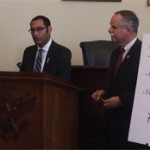
Every day, I reflect on what an honor it is to help lead the ACR during this most critical time for medicine and its associated professions. This role is also challenging, as this is the most volatile time that any of us can remember. Right now, we face several important issues that will profoundly affect all of the members of the ACR. I am ready to face all of them with you during the next year, with the help of our board of directors, its committees, and our impressive staff.
Many unprecedented issues will confront our members, whether they are primarily clinical practitioners or those whose work is mainly scientifically oriented. We have long sought relief from the albatross known as the Sustainable Growth Rate (SGR). The set of expectations that is likely to replace the SGR will require great changes for all of us.
This month, I would like to address efforts to replace the SGR, discuss what this will mean for patient care and reimbursement for that care, examine how the ACR will be helping our members prepare for what will be a new world, and, finally, explain what we need you to do.
How We Got to the Edge of the Cliff
The SGR formula is a payment system whose effectiveness ended many years ago. Enacted in 1997 to update payments and rein in costs, the SGR ties Medicare physician payment updates in part to economic growth, as measured by changes in Gross Domestic Product. But the SGR has proven unworkable. Since 2003, Congress has had to step in to block the catastrophic cuts in payments the formula called for each year.
The next SGR cut will be on January 1, 2014, to the tune of almost 25%, unless Congress repeals the SGR or steps in again with yet another temporary fix. The result of this cycle of payment cuts suspended at the last minute has been not only perennial fear and uncertainty about whether practices or academic units will be able to serve Medicare patients or even operate, but also a growing cost for permanent SGR repeal each time a temporary fix is passed.
Rheumatologists and our colleagues in other specialties have petitioned Congress for years about the insanity of “cliff drop” cuts related to this unworkable formula and about repealing the SGR. In 2013, Congress began to really listen and to formulate a potential solution, especially in the context of healthcare reform. However, three questions remain: 1) What will the new system look like for rheumatologists? 2) Will we continue to lend support to Congress so they finally get us off this cliff? and 3) How can the ACR help our members in this new territory?
